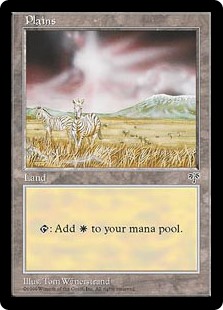
My recent land ratios article has had me thinking hard about all the factors that go into establishing a land count. I wanted to see if I could distill them all and thus create some sort of rule. I have low hopes on the matter as rules (as in the "if X then do Y kind" rather than the official rules of the game) in magic are less consistent than those about the English language... Essentially I am just looking for more ways to validate my land counts that are based on experience with some logic.
There are some obvious things going on as well as some more subtle things. The trick is to appropriately gauge the relevance and interplay of those things in determining the overall optimal count. I will be touching on and expanding on a lot of the same concepts as in the land ratios article. It was trying to answer a couple of specific questions while this is trying to understand the general trends at work.
The first most obvious element in determining how many lands you want is the average CMC of your deck. The higher the average CMC the greater the land count, pretty simple stuff. This on its own however is pretty meaningless. For it to be useful we have to say what average CMC gives a certain land count and then know the rate of change for land relative to a change in CMC. The issue is that the scaling is not linear. Adding land has a double whammy effect of giving you a higher land count and therefore more mana to spend but it also reduces the overall average CMC of your deck. Doubling the CMC of your cards certainly does not equate to doubling your land count, that would be mental!

At the lower CMC end of things there are issues as well. For all normal magic decks there is simply a low end limit on the lands you want to play. Even if every spell you have costs exactly one mana you still just need a certain amount of lands in order to consistently draw some. It is also beneficial in terms of speed to have three land in your first three turns despite this being more than you "need". For such a deck, one or two lands would be optimal over the course of a game if you started without a hand. As you begin with this pile of resources you need a little more land to quickly and efficiently expend them. A two land draw in the deck of one drops takes six turns on the draw to use all its cards while a three land draw from the same deck is done on turn four. If your deck is all one drops and isn't benefiting from speed then I am sure something is being done wrong.
All that is to say that there is a point at which reducing your curve so that you can cut lands stops being useful. You are better off playing some heavier cards and keeping a sensible land count. Land ratios are all about hitting that Goldilocks sweet spot of not too many and not too few. Due to the direct link between average CMC of your deck and your land ratio the Goldilocks "rule" applies to your average CMC to some extent as well as your land count.
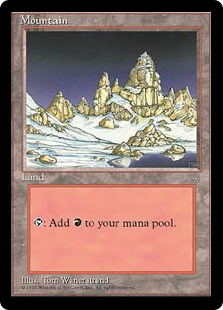
Think of it like this, a heavy control deck runs two risks, either it draws too many lands and does not have enough stuff to win with or it draws too few lands and cannot cast enough of the heavy stuff. An aggro deck is afraid of exactly the same thing, too much land and not enough power or too much power without the ability to play it. The trick to making both decks better is identical but opposite because of where they start on the spectrum. The heavy 18 land control deck typically benefits from a reduction in average CMC alongside a reduction in land count. This means cutting a land for a spell but it also means cutting a couple of other expensive spells and replacing them with cheaper ones otherwise the average CMC will rise. A higher card density with a lower overall cost greatly helps the performance of the deck.
The aggro deck can improve its performance by increasing the average CMC although it is a little more complicated in this example and relates to the range of cards. Take Firebolt and Burst Lighting for example, both are essentially one drops and would be considered as such in your deck however both have much higher mana cost options. The least you can spend on either is one mana for it to be useful in your deck however you can spend five or six on them and milk them a little harder for gas.
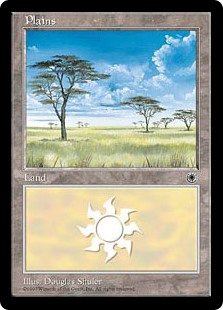
When considering what the average CMC of your deck is you should very much consider both ends of your range on cards. Snapcaster Mage can be a two drop or a six plus drop, you usually want to be playing it around a four drop. It is not an exact science but you know it is two at least and can work out what it is at the top end from your deck. Most people base their average CMC on the low end of their cards ranges which is fine so long as you know you are doing that. For some reason only Den protector gets put at the curve on three, all the other cards like that get put on the curve at their lowest CMC range. If you do just this you have to hedge on the side of more lands. If you have a look at the potential upper ranges on your deck you will find it is usually pretty insane by comparison. You could work out your mana base from this upper average CMC and very reasonably play a couple of extra lands based on that most of the time. Again, we are looking for the Goldilocks spot with a land ratio suited to a reasonable middle ground between our lowest possible needs and our most extravagant possible spending. Aggressive decks tend to suit having their range on lower to upper CMC extended without changing the low end point. This basically means playing Lightning Berserker over Jackal Pup, Kargan Dragonlord over Ash Zealot, Abbot of Keral Keep over Lightning Mauler and so on and so forth. None of these replacements cost any more to play at the low end yet all have a pretty vast range over the originals. This is how to improve aggressive decks in the cube. Play more lands so that you consistently curve out at the start but play cards with a high CMC range so that you are at far less risk loosing to a flood situation.

The importance of redundancy, consistency and speed in an aggro deck outweigh a lot of other concerns. You will forgo a lot of power for it and this is why you don't really want to increase the low end of your average CMC. Playing anything is still better than playing nothing and making sure you don't do nothing in the early turns is far more important than it is for the later ones. Considering the average is all well and good but it is not quite that simple. The top of your curve is also incredibly significant in determining your land ratios. Regardless of the average CMC of the deck the one which has nothing more expensive than a 3 drop will need less land than the deck containing five drops. While it is easy to know where your curve ends, much like it is easy to work out your average CMC, it is far from simple to know what to do with that information. There are both numerical factors like the average CMC affecting this as well as contextual things. All the contextual stuff gets instantly complicated as it requires an understanding of the cards and the game rather than just maths. It is not just about the CMC cap of your deck but when you need to hit that cap. If you are trying to curve out or win in a short order then your cap is pretty hard and it is important to have enough land in your deck that you are naturally drawing to your cap somewhere in the 70%+ region. A zoo deck for example that wants to curve out and ideally wants to goldfish on turn four and contains four drops that it wants to cast turn four. This means unless you draw four land in 10 or 11 cards your four drops have a high chance of being very weak in the deck.
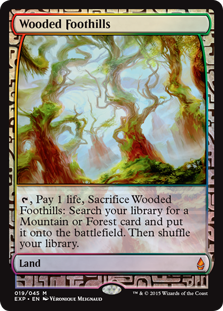
The more proactive the deck the more it is trying to win on or as near to as possible its goldfish. This means that they have a much harder cap on CMC stuff. Top of curve stuff rapidly loses value without supplementing it with sufficient land. More midrange and control decks have slower and more variable expected game lengths. As they are not expecting to win on turn five they can include five drops without a high expectation of being able to play them on turn five and still have them be good inclusions. Control decks typically have six and even seven drops (Karn, Aetherling!) however these are soft CMC caps. These are just your finishers and super heavy cards that give you the required inevitability. A high soft CMC cap still requires attention in terms of land count but it is a far less significant factor in terms of land increase than a hard cap demands. Control decks still have a hard cap of sorts but it is context based. It is when you have enough power to take control of the game, usually four with Wraths and powerful planeswalkers and the ability to do two relevant things in a turn. This means a control deck might well have a seven drop but actually want the same land count as a Zoo deck than ends at four. There will be other things going on as well affecting this but the primary one is that both decks really want to see four lands in the first four turns. Knowing your CMC cap is easy but knowing if it is hard or soft is contextual. If it is soft then assessing which is the key point isn't always obvious.
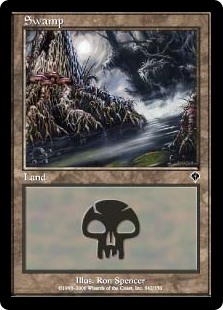
The time in which you hope to win a game has a huge impact on your mana ratios and indeed the cards you will look to include in your deck. A lot of midrange decks are blessed in their sloth by having a hard CMC cap of three. They can happily wait a couple of extra turns for their four and higher drop cards to come online as they have such high power and value cheap stuff. While they might well "need" the four drops to win the game, the time and value they are gaining with the two and three drops ensures they will get there. Knowing when you can win with a deck, when you want to win and the turn ranges you typically win are all important factors for matching a mana base to it.
To illustrate this I want to look at the modern burn deck and a theoretical cube version of the deck that I looked at in the land ratios article. The cube deck has 16 lands, 12 one drops, 8 two drops and 4 three drops. The deck is 40% land and the spells have an average CMC of 1.66 mana. This is pretty much the template for which I aim to have my cube mono red aggro decks follow. The modern burn deck is 24 one drops, 16 two drops and 20 lands. It is 33% lands and the spells have a 1.4 average CMC. At a glance these decks look very different in their mana base and to a degree quite reasonably so. The cube deck has as a higher average CMC and a higher CMC cap and so playing the higher land count makes sense. The subtle thing going on that isn't obvious from the figures I have given is that both decks have an identical ideal goldfish. Both want to win on turn four and they want to do so in a very similar manner. If you look at the decks average CMC rather than just the spell average you find that they are incredibly similar. For the cube deck it is 40/40 or 1 mana per card and for the modern deck it is 56/60 or 9.33 mana per card. Both decks have pretty reasonable odds on being able to exactly use all their mana up to and all their cards on turn four. It is the turn ranges you aim to win with for your deck that are the strongest factors in determining what CMC average your spells should have more than any thing else. A deck aiming to win as quickly as possible wants the deck's average CMC to be around one. Too much over that and your goldfish average will be more like a 5 than a 4.
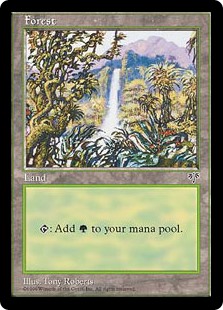
It is hard to build a viable cube deck with an average deck CMC above 2 (or a 3.5 spell average). Cards you are cheating into play don't count! The only way to get these kinds of high average CMC in a viable deck is with a lot of ramp and that is a whole nother section! Decks without a heavy ramp or burst mana theme are typically in the 1-2 range of average CMC. The closer to 2 average CMC you get the closer to turn ten you get with your expected or average win turn. A 1.5 average is around turn 6. For control decks this is less the turn you win and more the turn you generally turn the tide and take control of the game. There is a good reason that at the low end of the average CMC an increase only has a small number of extra turns added to the goldfish while nearer the 2 average CMC mark you are getting more turns added on to your goldfish than you would for the same increase at lower average CMCs. All decks regardless of their aims, ratios or whatever, will more consistently make lands at the start of the game than they will towards the end of the game. In Hearthstone you know you will have had 55 mana on your 10th turn. It is incredibly rare for a Magic deck to do this with lands au naturale. They might have had 55 mana by turn 4 though! Even a deck with a lot of land that should consistently hit four mana but turn four still won't consistently be making lands after that point and probably won't get much past 40 total mana by turn ten (assuming no ramp).
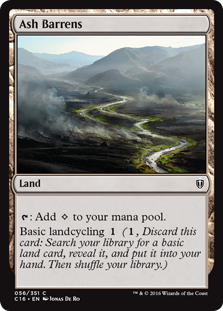
If you look at statistics for the % chances for getting a number of lands on a given turn with a given initial land count then they all look somewhat like a bell curve. If your ratios are such that you have the highest chance of having exactly four lands after 10 cards then you will find (rather unsurprisingly) that your next most likely outcomes are to have either exactly 3 cards or exactly 5. These will both be in the same sort of magnitude as your most likely outcome however further away from these middle options is increasingly unlikely. As you are dealing in whole numbers the chances either side of your mode land count are not necessarily equal, odds on they are not. When you change your land ratios in a deck you will essentially be moving the bell curve left or right. More lands moves the bell curve right and less to the left. When building a deck you want the appropriate bell curve for your hard CMC cap. If your hard CMC cap is 4 mana then you want a land ratio where 4 lands by turn four is the most common outcome and you probably want 5 lands by turn four to be favoured over just 3 lands on turn four outcomes. Context comes in quite significantly again here as you need to assess the risk of flood vs screw. If your soft CMC cap is no higher than your hard CMC cap (more common case for aggro decks) and flooding is a bigger risk than screwing then you want to shift the curve more to the left. As either of these things ceases to be the case the more you will want to shift the bell curve to the right with extra land.
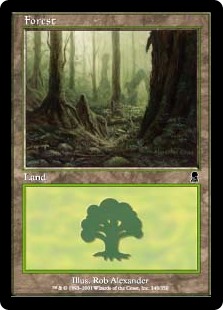
Ideally what you would do for those decks where the soft and hard CMC caps are equal or very near that is change the shape of the bell curve. The steeper you are able to make the sides so to speak the better. If by some magic you could increase your odds of hitting four land on turn four while reducing the chances of having 3 or 5 then you are onto a winner. This can be done to some extent but it comes with other costs. The only way to change the shape of the curve is by using the effects of cards and their interactions. Just adding or removing lands makes the curve bigger or small and shifts the peaks position relative the the axis but it isn't able to affect the shape. It still looks like a bell with all the same curves. Card quality is a way to achieve an actual change to the shape of the curve. If you assume that you loot/scry away every land in favour of cards when you are in excess of your ideal count and vice versa when you have not hit that mark then your bell curve will narrow. The more card quality you have the more this effect will happen. The thing is card quality is not free and means you are spending resources on not doing other things. Adding card quality into something like a burn deck does improve your consistency but it also increases the average CMC of your deck at the same time. Even if it looks like the average CMC remains the same this is not the case if you replace an action spell like a Shock for something like a Slight of Hand. Your mana per card may be the same but your mana per damage has increased and as that is how your deck is winning you have effectively slowed it down.
Deck thinning is a great way to make your bell curve asymmetric. The modern burn deck really never wants to see more than 3 land and can be quite content on 2. It is really important to hit those first two every game but almost just as important not to hit a 4th. In the modern burn deck if you used only 20 basic land you have just over a 12% chance of have 1 or fewer lands by turn 3 (on the play), a 24%(ish) chance to have exactly 2, a 30%(ish) chance to have exactly 3 yet still a 34%(ish) chance of having four or more lands. This is a bit of a problem as the bell curve is so wide relative to the range you want. Both one or less and four or more are pretty disastrous outcomes yet are pretty close to 45% of the possibles. Muligans take quite the edge off this as you can fairly well see which starting hands (7/9ths complete information) have a high chance of landing in the danger zones. Sac lands are the other thing that greatly help the situation specifically for the modern burn deck. With half or more of the lands they play also removing lands from the library the effect is to make the downslope of the bellcurve that much steeper than the upslope. It means if 3 lands is your goal and at the peak of the curve then 2 lands will be notably more likely than 4. Everyone knows that thinning your deck of lands reduces your flood risk however understanding the mechanisms behind that process and how best to apply it is useful.
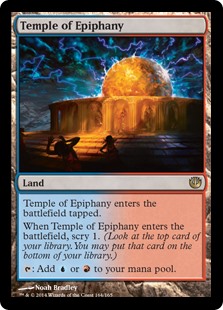
Next up we have card draw. This is a good way of widening a bell curve and is the preserve of control decks that typically have the widest gap in their hard and soft CMC caps. Widening your bell curve means that you will have increased odds on continuing to make land drops each turn. This means you can play the correct number of lands to hit your hard CMC cap reliably and not flood overly in the early stages of the game while still reaching your soft CMC cap fairly close to the corresponding turn mark. A 17 land cube control deck fairly often lays land each turn all the way to turn six or seven while a zoo deck of the same count wont often hit its 5th land on cue and really doesn't want to have seven lands ever, even by turn seven. The difference between the two lists is pretty simply the card draw. Zoo has little and control has a bunch.
The difficult thing about considering card draw effects is when you are able or actually want to cast them. Fact or Fiction cannot affect your curve before 4 land or turn 4 and odds on you are only casting it then if you can't do something else. A heavy card like a FoF really only helps the very top end of your deck to come out in good time. Accounting for a FoF with the shape of your bell curve is somewhat of an approximation. It does nothing at all to affect anything pre 4 lands and turn 4 and then it has a very small affect on the area of the curve there after that slowly increases a bit with more turns. A card like a Peek will affect the curve much sooner. Obviously you don't always draw it so it really is quite a small effect. A single Peek you can always cast on turn one if you have it means you can roughly assume you start with 7.14 cards rather than 7 for the purposes of working out how many lands you will see by point X on average. Widening your bell curve once you reach the middle point is good if you want to hit more lands. Widening it potentially from nearer the start of things and you will affect things for both your hard and soft CMC cap targets. Basically what I am trying to say in a round about way is that heavy expensive card draw is great for going long but helps in no way to get you to that point. Cheap card draw (and cycling effects) help in some regards going long and in getting there but they are more impactful on your overall land to card ratio and may well require you to play fewer lands or risk flooding when you have a lot of them. If you have a load of two drop cyclers and reliably get to two mana than you can tweak things a little so that your you have slightly fewer lands than you might otherwise want to cast three and four drops on cue. Many of the cheaper card draw cards are also card quality effects and that is doubly good as it lets you alter both the shape of the curve and also the area under it. The draw just generically increase the area, in other words means you will see more land, the quality/filter lets you tweak the shape a little according to your needs.

Lastly we have ramp effects. These have a similar effect to card draw and a similar effect to lands. There is a feedback going on where more ramp means you hit your CMC caps sooner and thus improve your expected win turn. By finishing sooner you are given incentive to lower the average CMC of your deck however as ramp cards also proxy as lands you are greatly increasing your capacity for casting things and this makes you want to increase the average CMC of your deck. As these are cross purpose the general solution is to raise the CMC caps on a deck with ramp but not try and win quicker. If you raise the CMC cap from say five to six but add sufficient ramp that you are likely to hit six mana on turn five then you will still be winning in about the same time frame but you will do so with a lot more power to back you up. Obviously you can use ramp to speed up a deck but then it is a different deck and needs a reworked mana base. If you just add ramp into a deck and keep the land count the same you want to add in more expensive cards otherwise your ramp is going to hurt you more than help you.
Ramp is like card draw in that it increases the area under you land chances bell curve but it doesn't do anything at all until you cast it. Two mana ramp cannot in any way be substituted for lands that you need to reliably get you to two mana. There is also the fact that ramp purely costs you tempo when you are using it instead of land drops. It is only helpful when you are ramping and making lands and then making something with it before you should be able to, or at least two somethings. All this is basically just a round about way of saying ramp shouldn't have that much impact on your actual land count. Play too few lands with your ramp and you will just wish your ramp cards were lands a lot of the time. Play too much land and ramp and you will either perpetually flood or just have the most inconsistent deck in terms of being able to efficiently spend its mana every turn. I am pretty sure you could make a cube deck that fairly consistently could cast an Eldrazi 10 drop style card by turn five however that is all it would do and it would frequently lose to a single disruption card or simply not drawing one of the actual threats. Ramp is good but it is not a replacement for lands, more an extension of them. It should be used to extend your mana curve higher and allow for increased average CMC of your cards but it shouldn't be used to replace lands. Replace a spell with a ramp card and then another spell with a bigger one is the sentiment. You can only replace a land with a ramp card sensibly when you have too many lands for the deck yet the right amount for the CMC caps. You can consider most ramp cards to be like lands or at least half lands (for the vulnerable or overly expensive ones) when you are looking at the average CMC and CMC cap of your list but not for your chances of drawing lands, often in fact ramp spells thin your deck (Sakura Tribe Elder etc) a thus command an increase in land counts to consistently make your lands drops. Ramp is perhaps the hardest to assess in how you need to change up your various ratios and compositions as it is so contextual. Grading the ramp that a Rofellos will offer is tough, he is usually nothing because he is killed on sight or more than you need to win right away! A simple Talisman is rather easier to evaluate but still requiring loads of approximations and assumptions.
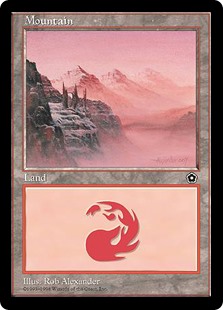
So what have we learned? To summarise we have a few key concepts that determine a lot of the things you want to aim for with your deck. You have the average CMC of your list and the hard, and to an extent the soft, CMC caps which help determine how many lands you want. You also have the speed at which your deck wants to win or can expect to win in typical games. This has a significant impact on the average CMC of your list. You likely have the effects of card draw to consider and how that will increase the overall number of lands you see. You have to consider the cost of these card draw effects so as to determine which areas of your curve they will effect. There are card quality effects that can greatly help an imperfect situation but that shouldn't change you from aiming for the optimum build assuming that you had none. There are card draw effects that can greatly help bridge a gap between hard and soft CMC caps or with the cheaper ones be used to reach the hard cap. The latter use comes with the extra risk of flooding which in turn should be accounted for in the build. There are tricks you can use to offset the downsides of too much land without cutting land and increasing the dangers of too few such as deck thinning and mana sinks. Alternatively you can use ramp effects to increase your various CMC measures without having to play too many lands. You want to avoid cutting cheap cards out of your deck as having nothing to do in an early turn is an issue. This typically means ramp decks replace 3 through five drops with six and seven drops. The number of cards from 3+ is roughly the same yet they account for all the increase in the average CMC of the deck.
The thing that I learned from all of this is that it is actually mana bases that determine decks and not the other way round. I used to think I built a deck and then fitted a mana base to it however in reality I have always been building around the confines of what a mana base will allow and using tools at my disposal to bend those rules slightly. There are a few fundamental things about magic that ensure the land ratios for all kinds of deck observe some similar trends. You always start with a pile of resources and aim to expend them over the course of the game. The general flow is starting with seven and then only getting one card per turn there after. This means you have good odds on your early land drops but increasingly poor odds on subsequent ones. You can change these odds but you cannot alter that trend. There is also the fact that even a deck where every spell costs one, because of the starting hand size again, that you still want more than one land. Every deck wants some lands and because you are playing some lands you play a sensible amount that does something reliably. Due to this you want somewhat of a mana curve to spend this more reliable mana on. Two fifths lands is about the Goldilocks value. Shockingly this applies comparably to quicker decks and slower decks. The speed of the deck affects the average CMC rather than the land ratios directly. It is more the ways in which we tweak the cards in quicker and slower decks that deviate the land ratios away from 40%. A deck with an average CMC of around one or less cannot sensibly reduce its land ratio as a way to improve its power per card and so is better of simply playing some slightly more powerful and slightly more mana intense cards. Equally, a deck cannot go much beyond an average CMC of two without the use of ramp cards. It if does it will either not have enough cheap spells to cast in the early turns consistently or it will not draw enough lands to ever cast the higher points of the curve in time. Lands and how they work have far more effect on decks and card choices than the other way round. Now that I have written that down it seems really obvious but before I composed this article it is not something I was aware of.
It is nearly two years since I wrote this. At that time most sealed and draft decks I did in the cube had 16 or 17 lands in 40. These days, with just two years worth of new cards, I have found that I play about one less land on average in the same kinds of deck. Testament to increasing card potency. I wonder how many lands I will be running in 2020? There is certainly still more room for land reduction given that the last constructed deck I ran had 19 lands in 60!
ReplyDelete